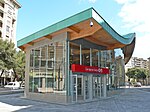Clinic of Zaragoza radiotherapy accident
1990 disasters in Europe1990 in Spain1990 industrial disasters1990s in AragonDecember 1990 events in Europe ... and 6 more
Disaster stubsHistory of ZaragozaMan-made disasters in SpainMedical errorRadiation accidents and incidentsUse mdy dates from August 2021
The 1990 Clinic of Zaragoza radiotherapy accident was a radiological accident that occurred from 10 to 20 December 1990, at the Clinic of Zaragoza, in Aragon, Spain. In the accident, at least 27 patients were injured, and 11 of them died due to the overexposure, according to International Atomic Energy Agency (IAEA). All of the injured were cancer patients receiving external beam radiotherapy.
Excerpt from the Wikipedia article Clinic of Zaragoza radiotherapy accident (License: CC BY-SA 3.0, Authors).Clinic of Zaragoza radiotherapy accident
Avenida de San Juan Bosco, Zaragoza Delicias (Delicias)
Geographical coordinates (GPS) Address Nearby Places Show on map
Geographical coordinates (GPS)
| Latitude | Longitude |
|---|---|
| N 41.6434 ° | E -0.9055 ° |
Address
El Rincón
Avenida de San Juan Bosco
50009 Zaragoza, Delicias (Delicias)
Aragon, Spain
Open on Google Maps










